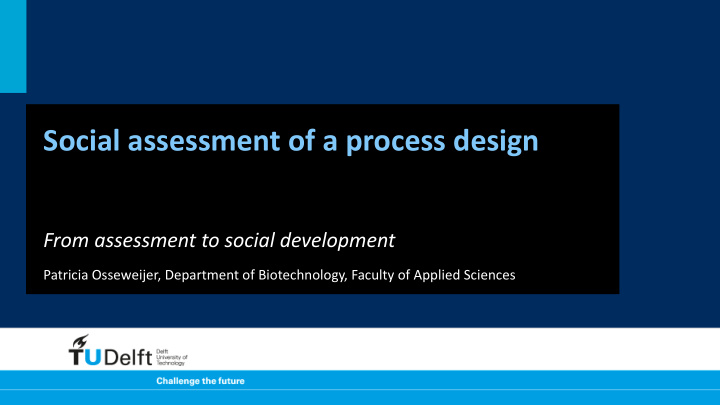



Social assessment of a process design From assessment to social development Patricia Osseweijer, Department of Biotechnology, Faculty of Applied Sciences
Social sustainability is part of overall impact PPP (People-planet-profit) concept: Weakness in any of these may lead to a “no-go” People Bearable Equitable Sustainable Planet Profit Viable
Sustainability: “A Safe and Just Space for Humanity” After Oxfam, 2012
Methods for social impact assessment Social Life Cycle Assessment (SLCA) UNEP/SETAC* • Stakeholder categories: from stakeholder perspectives • Impact categories: from product perspectives Life Cycle Attribution Assessment (LCAA) • Attributions of activities: from activity perspectives *United Nations Environmnetal Program/Society of Environmental Toxicology and Chemistry
Example of SLCA Stakeholder Impact Sub- Imv. Inventory categories categories categories indicators data Workers Human rights Local community Working conditions Society Health and safety Consumers Cultural heritage Value chain actors Governance Socio-economic repercusions Assesment system from categories to unit of measurement. Adapted from benoit et al., 2007 Wu et al., 2014; Sustainability 2014 , 6, 4200-4226
Indicators for social sustainability GBEP* • Allocation and tenure of land • Price and supply of national food basket • Change in income • Jobs in the bioenergy sector • Changes in unpaid time spent by women and children collecting biomass • Bioenergy used to expand access to modern energy services • Change in mortality and burden of disease attributable to indoor smoke • Incidence of occupational injury, illness and fatalities *GBEP: Global Bioenergy Partnership The GBEP Sustainability Indicators for Bioenergy , GBEP, December 2011, ISBN 978-92-5-107249-3
Indicators for social sustainability GBEP* • Allocation and tenure of land • Price and supply of national food basket • Change in income • Jobs in the bioenergy sector • Changes in unpaid time spent by women and children collecting biomass • Bioenergy used to expand access to modern energy services • Change in mortality and burden of disease attributable to indoor smoke • Incidence of occupational injury, illness and fatalities *GBEP: Global Bioenergy Partnership The GBEP Sustainability Indicators for Bioenergy , GBEP, December 2011, ISBN 978-92-5-107249-3
Goal and scope definition Cradle-to-grave ? Air Recycle Cradle-to-gate Energy Water Materials Energy Land Waste Raw materials Products Feedstock Use Management What are the societal impacts of a bio-based process? ... And how do they compare to other production modes?
Social indicators within biomass supply chain Feedstock Feedstock Conversion Biofuel Biofuel production Logistics to Biofuel Logistics End-uses Land Harvesting & Conversion Transport Engine type & Conditions Collection Process efficiency Feedstock Processing Fuel type Storage Blend type conditions Management Storage Co-products Categories of major indicators: Socioeconomics Profitability Social well being Transport External trade Energy security Resource conservation Social acceptability Dale, V., efoymoson, R., Kline, K., Langholtz, M., Leiby, P., Oladosu, G., Davis, M. Downing, M., Hilliard, M. (2013). Indicators for assesing socioeconomic sustainability of bioenergy systems: A short list of practical Categories without major effects measures. Ecological Indicators. 26:87-102(2013)
Data collection & interpretation • Interviews • Meetings • Surveys • Web blogs • General databases A mix of quantitative and qualitative results CMPC, Brazil
Socio-economic impact assessment of business case Cradle-to-grave Cradle-to-gate Energy Energy Materials Waste Feedstock Products Management • Feedstocks • Transport • Processing (including pretreatment)
Socio-economic impact assessment: Feedstock indicators Employment & income : Is there increase in employment and income? Education & training : Have the new jobs a potential positive impact on schooling? Food security : Does the production of feedstock have any impact on food availability and prices? Productivity : How much product/hectare?
Socio-economic impact assessment Transport indicators Employment & income : Is there increase in employment and income? Education & training : Have the new jobs a potential positive impact on schooling? Infrastructure : How much biomass needs to be transported/day? Is the transport infrastructure adequate? Does is provide problems for local communities?
Socio-economic impact assessment Land management indicators Land tenure and allocation : How is ownership arranged? Harvesting : Have the new jobs a potential positive impact on schooling? Is there a policy for child labour? Soil quality : How is fertilisation and herbicidal resistance done? Health impacts: Are there toxic compounds involved? Energy security: Does the new feedstock management impact energy security?
Socio-economic impact assessment Processing indicators Energy security: Does the new conversion impact energy security? Social acceptance : Are the new technologies accepted? Employment and training : Are there new jobs created? Is training provided? Worker’s safety?
Integral assessment: standards PPP (People-planet-profit) concept: People Integrating results and weighing of factors Bearable Equitable Sustainable Planet Profit Standards for sustainable production Viable 12 principles developed by the Round Table for Sustainable Biomaterials http://rsb.org/sustainability/rsb-tools-guidelines/
Corporate social responsibility https://www.youtube.com/watch?v=B7dDSHwFgKk
Summary Social sustainability is: • Part of the overall sustainability profile • Providing information on how to improve social impact • In development • Related to normative aspects • Often influenced by external stakeholders (NGOs, policies, consumers)
See you next unit
Recommend
More recommend